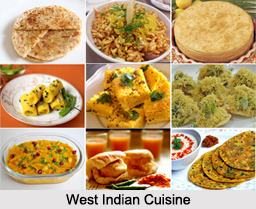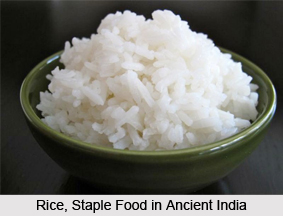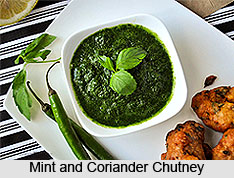 Chutney is a family of condiments made from a highly variable mixture of spices, vegetables, or fruit.The term itself is an anglicised form of the Hindi word "Chatni" meaning "to lick". Historically chutneys were only eaten on special occasions like weddings or by the economically affluent. Chutney, as a genre, is often similar to the Indian pickle. Traditional cooked chutneys made for home consumption were generally tinctured or slowly cooked in the sun over a period of several days, until they achieved the right flavour and uniformity. This method is still used in modern India in homes which do not make use of stoves.
Chutney is a family of condiments made from a highly variable mixture of spices, vegetables, or fruit.The term itself is an anglicised form of the Hindi word "Chatni" meaning "to lick". Historically chutneys were only eaten on special occasions like weddings or by the economically affluent. Chutney, as a genre, is often similar to the Indian pickle. Traditional cooked chutneys made for home consumption were generally tinctured or slowly cooked in the sun over a period of several days, until they achieved the right flavour and uniformity. This method is still used in modern India in homes which do not make use of stoves.
Types of Chutneys
Chutneys can be prepared from an extensive array of ingredients and hence representing umpteen types of flavours and textures. Chutneys can be made from almost any combination of vegetables, fruits, herbs and spices. As with other condiments, chutneys are based on a wide range of recipes and preparation methods, they vary widely by geography, they can range from a wet to dry or coarse to fine and they can be combined with a wide variety of foods or used for dipping. Chutneys are usually grouped into sweet or hot forms; both forms usually contain spices, including chilli, but differ by their main flavours.
Vinegar, citrus, tamarind, or lemon juice may be added as natural preservatives, or fermentation in the presence of salt may be used to create acid. The use of a stone mortar and pestle is often looked at as a vital tool to create ideal chutney. Electric blenders can also be used as alternatives to stone grinding. The first chutney in India was sticky fruit based preserves.
On the other hand, chutneys can again be classified into two distinct categories: freshly-made preparations for right away consumption and cooked preparations intended to preserve as long as a year, which can be clubbed further according to their saltiness, sweetness, tartness, or spiciness. Many chutney recipes combine several elements of these basic flavours. Textures in chutneys range from roughly chopped preserves to smooth sauces.
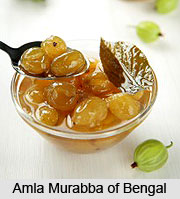 1. Mint and Coriander Chutney Ingredients:
1. Mint and Coriander Chutney Ingredients:
1/2 cup water
2 cups fresh mint leaves
2 cups fresh coriander leaves
1/4 cup fresh green chillies
2 tbsp fresh lemon juice
2 large garlic cloves
3/4 tsp salt
1/4 tsp cumin powder
Method:
In a large blender, add the water followed by the mint leaves, coriander leaves and green chillies. Add in the lemon juice, garlic cloves, salt and cumin powder. Blend the mixture for a few minutes until it is pureed.
2. Amla Murabba of Bengal Ingredients:
1 kg amla
2 tsp chemical lime
1 1/2 kg sugar
6 cups water
1 Tbsp lemon juice
Method:
Prick amla with a fork. Dissolve 1 tsp lime in water and soak amla overnight. Remove and wash well. Repeat once more. Drain and wash thoroughly. Squeeze and rinse to eliminate lime remains. Boil water then add amla. Cook till tender and transparent. Drain and keep aside. Make syrup with sugar, lemon juice and 6 cups of water. Maintain one thread consistency, skimming off any scum that keeps forming. Add amla, bring to a boil and simmer for 4-5 minutes. Let it cool, then store in a clean airtight jar. You can add cardamom powder or any other flavoring of your choice. This can be stored for 7-8 weeks.
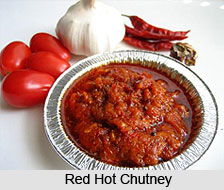 3. Red Hot Chutney Ingredients
3. Red Hot Chutney Ingredients
Tomato -1
Garlic cloves-5
Dry Red Chilli -2
Salt
Red chilli powder -1 tbsp
Water (optional)
Method:
Cut tomatoes and red chillies into half. Add garlic cloves, salt and red chilli powder. Add a little water if the consistency is too thick. Blend all the ingredients. Serve with momos.
Chutney styles are strikingly different in various parts of the country, with their own version and also differentiated among different religious groups such as Jain, Parsi, and Sindhi chutneys come into the list of Indian chutneys.
Health Benefits from Chutneys
Indian chutneys and its methods of preparation employing nutritious vegetables or fruits make up a significant get-well prescription in Ayurvedic dietary. Hence, Ayurvedic Pickles and chutneys like Ayurvedic Coriander chutney, Ayurvedic Coconut Chutney, Ayurvedic Mint chutney and Ayurvedic Tomato chutney are useful in the long run to lead a healthy lifestyle, even though one is consuming unhealthy food.
Indian variation of chutneys can be reliably personified to redefine vastness and colossal in matters of taste and smell. The immense types of chutneys grouped under the abstract Indian food and cookery section reflects expertise of native kitchens and the secret art employed to create a masterpiece.
